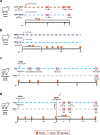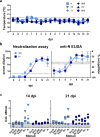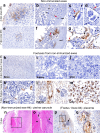The 40Fp8 vaccine strain is safe and protects pregnant ewes from a virulent RVFV challenge
- PMID: 40883324
- PMCID: PMC12397403
- DOI: 10.1038/s41541-025-01250-6
The 40Fp8 vaccine strain is safe and protects pregnant ewes from a virulent RVFV challenge
Abstract
In the present study, we evaluated the immunogenicity, safety and protective efficacy of the attenuated RVFV-40Fp8 strain in natural hosts (non-pregnant ewes) and in a highly susceptible host infection model such as pregnant ewes in the first third of pregnancy. Our results confirm the immunogenicity of 40Fp8 administration in non-pregnant and pregnant ewes, as well as the absence of foetal damage even after a high-dose vaccination regime in pregnant ewes. In addition, the ewes and their foetuses were protected against a virulent RVFV-56/74 strain challenge, as shown by comparative evaluation of blood, serum and different tissue samples from vaccinated and non-vaccinated pregnant ewes. These results confirm the potential use of 40Fp8 as a RVF live-attenuated vaccine candidate and pave the way for further clinical developments.
© 2025. The Author(s).
Conflict of interest statement
Competing interests: A.B., B.B. and S.M. are the inventors of patent WO/2021/245313 (application PCT/ES2021/070403), which was filed with the Spanish National Research Council (Agencia Estatal Consejo Superior de Investigaciones Científicas, CSIC) and is currently being extended to several third countries. This manuscript supports the safety and efficacy of a vaccine candidate that is the subject of patent protection. All other authors declare no competing interests.
Figures










Similar articles
-
Brucella melitensis Rev1Δwzm: Placental pathogenesis studies and safety in pregnant ewes.Vaccine. 2024 Jun 20;42(17):3710-3720. doi: 10.1016/j.vaccine.2024.04.085. Epub 2024 May 15. Vaccine. 2024. PMID: 38755066
-
Immunogenicity and seroefficacy of pneumococcal conjugate vaccines: a systematic review and network meta-analysis.Health Technol Assess. 2024 Jul;28(34):1-109. doi: 10.3310/YWHA3079. Health Technol Assess. 2024. PMID: 39046101 Free PMC article.
-
Prescription of Controlled Substances: Benefits and Risks.2025 Jul 6. In: StatPearls [Internet]. Treasure Island (FL): StatPearls Publishing; 2025 Jan–. 2025 Jul 6. In: StatPearls [Internet]. Treasure Island (FL): StatPearls Publishing; 2025 Jan–. PMID: 30726003 Free Books & Documents.
-
Rev1Δwzm vaccine candidate is safe in young and adult sheep and protects against Brucella ovis infection in rams.Vaccine. 2024 Sep 17;42(22):125998. doi: 10.1016/j.vaccine.2024.05.046. Epub 2024 May 27. Vaccine. 2024. PMID: 38806353
-
Vaccines for preventing influenza in healthy adults.Cochrane Database Syst Rev. 2018 Feb 1;2(2):CD001269. doi: 10.1002/14651858.CD001269.pub6. Cochrane Database Syst Rev. 2018. PMID: 29388196 Free PMC article.
References
Grants and funding
- PdC2021-121717-I00/Agencia Estatal de Investigación
- PdC2021-121717-I00/Agencia Estatal de Investigación
- PdC2021-121717-I00/Agencia Estatal de Investigación
- PdC2021-121717-I00/Agencia Estatal de Investigación
- PdC2021-121717-I00/Agencia Estatal de Investigación
- PdC2021-121717-I00/Agencia Estatal de Investigación
- PdC2021-121717-I00/Agencia Estatal de Investigación
- Next Generation EU/PRTR/European Union
- Next Generation EU/PRTR/European Union
- Next Generation EU/PRTR/European Union
- Next Generation EU/PRTR/European Union
- Next Generation EU/PRTR/European Union
- Next Generation EU/PRTR/European Union
- Next Generation EU/PRTR/European Union
LinkOut - more resources
Full Text Sources

